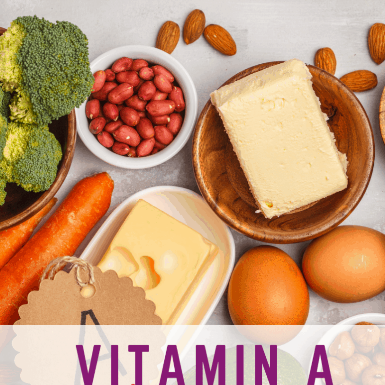Vitamin A plays an important role in vision, skin, cell production, the immune system and protection from infection. Children who eat diets rich in vitamin A, especially from plant sources, have been shown to be healthier and have fewer illnesses.
1. Vitamin A is essential for children's development
Vitamin A is a micronutrient that plays an important role in the health and comprehensive development of children. According to Associate Professor, Dr. Nguyen Thi Lam, former Deputy Director of the National Institute of Nutrition, vitamin A is a fat-soluble vitamin that protects the eyes, prevents night blindness and dry eye disease, ensures normal development of bones and teeth, protects mucous membranes and skin, and enhances the body's resistance to infectious diseases.
Vitamin A has four main roles in the body:
- Vitamin A helps growth: Regardless of its form, vitamin A acts as a cell-communicating component. Vitamin A helps children grow and develop normally.
- Vitamin A develops vision: The presence of vitamin A is an indispensable part of ensuring human vision.
Vitamin A not only supports vision but also helps children develop better.
- Vitamin A protects epithelium: Vitamin A protects the integrity of epithelium, cornea, skin epithelium, small intestine and excretory glands. Vitamin A helps prolong the aging process by preventing the development of free radicals.
- Strengthening the immune system: Due to its specific action on the body's cells, vitamin A actively participates in the body's immune system, increasing human resistance to disease.
2. Daily vitamin A requirements
According to the recommendations of the Institute of Nutrition, the daily dietary requirement of vitamin A is as follows:
Children
Children 6-12 months 400 mcg/day
Children 1-2 years old: 350-400mcg/day;
Children 3-5 years old: 400-500mcg/day;
Children 6-7 years old: 400-450mcg/day;
Children 8-9 years old: 500mcg/day;
Children 10-11 years old 600mcg/day;
Children 12-14 years old 700-800 mcg/day;
Children 15-17 years old: 650-700mcg;
Pregnant women in the last 3 months: increase by 80mcg/day;
Breastfeeding women: increase 450mcg/day compared to normal.
Associate Professor, Dr. Nguyen Thi Lam said that vitamin A deficiency causes dry eyes, dry cornea, keratomalacia leading to corneal scarring and permanent blindness. Vitamin A deficiency also causes degeneration and keratinization of epithelial cells, reduces the body's protective function; reduces immunity, increases the rate of illness and death in children. Vitamin A deficiency causes children to gain weight and grow taller slowly. Early vitamin A deficiency affects children's intellectual development when they reach school age.
The diet should include foods rich in vitamin A.
According to studies in the UK and the US, vitamin A deficiency can cause a number of serious health problems, starting in the womb. Vitamin A deficiency can weaken the immune system, cause dry and scaly skin, and cause impaired vision. In addition to some birth defects and poor growth in childhood, there is an increased risk of reproductive problems later in life.
Children with malabsorption problems, such as Crohn's disease, Celiac disease, and autism, are more susceptible to vitamin A deficiency and may need supplements.
Vitamin A can be stored in the body. Taking large amounts of vitamin A over a long period of time can cause serious problems such as birth defects, liver and nerve damage, skin problems, temporary jaundice, and abnormal bone growth.
Children who overdose on vitamin A may experience severe reactions leading to acute poisoning. The signs of poisoning can easily be confused with encephalitis, meningitis, and food poisoning, so parents need to pay close attention.
3. Foods rich in vitamin A should be given to children every day
There are two main types of vitamin A:
Metabolized vitamin A: This exists as retinol and is found in animal-based foods such as meat, fish, poultry, and dairy products.
Provitamin A: This is found in the form of carotenoids, primarily beta carotene. It occurs in plant-based foods such as fruits and vegetables.
According to Associate Professor, Dr. Nguyen Thi Lam, foods of animal origin have the most vitamin A or retinol. Because the liver is where vitamin A is stored, the liver has the highest retinol content. Fat from meat and eggs also contains a significant amount of vitamin A.
Feed children with adequate nutrition, train them to eat green vegetables, and get them used to many types of food.
Associate Professor, Dr. Nguyen Thi Lam said that the source of provitamin A - carotenoids is often found in some animal products such as milk, cream, butter and eggs. Plant-based foods are rich in provitamin A such as yellow/red fruits and vegetables, dark green vegetables, and cooking oils. When entering the body, provitamin A will be converted into vitamin A (in a ratio of 12:1 for ripe fruits and 22-24:1 for green vegetables).
Animal sources of vitamin A: Animal liver, red meat, fish, egg yolks, cheese, milk, yogurt
Sources of vitamin A from plants: Orange, yellow, red fruits and vegetables such as sweet potatoes, oranges, mangoes, carrots, papaya, gac fruit, etc. Many vegetables with dark green leaves such as broccoli, amaranth, Malabar spinach, Malabar spinach, water spinach, jute, etc.
Because vitamin A is fat-soluble, to help the body absorb vitamin A better, you should add fat to your daily diet. You should also not overcook vegetables because it will reduce the vitamin A content in the food.
According to SK&DS
Source




























![[Photo] Overcoming the heat, practicing to prepare for the parade](https://vphoto.vietnam.vn/thumb/1200x675/vietnam/resource/IMAGE/2025/6/21/b93392e8da8243b8a32040d19590e048)


























![[Maritime News] Wan Hai Lines invests $150 million to buy 48,000 containers](https://vphoto.vietnam.vn/thumb/402x226/vietnam/resource/IMAGE/2025/6/20/c945a62aff624b4bb5c25e67e9bcc1cb)












































Comment (0)